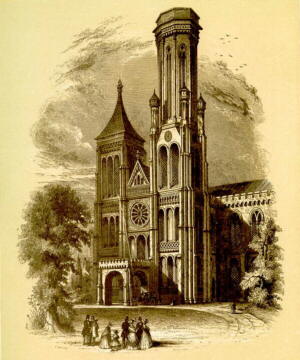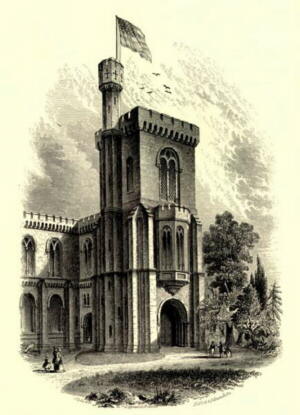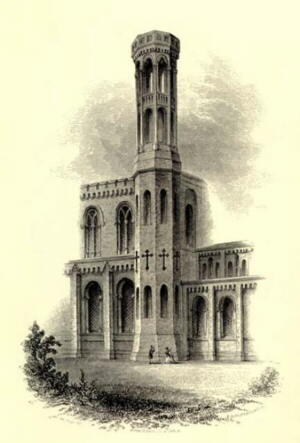Smithsonian Institution: World's Largest Museum Complex
|
Little did Robert Dale Owen of New Harmony, Indiana, know that the bill he introduced to Congress would establish the world's largest museum complex. Seen here is the entrance to "the Castle" - in a striking reddish brown sandstone recommended by Owen's brother, geologist David Dale Owen, himself owner of a museum known in its day as the largest west of the Allegheny Mountains.
The story of the Smithsonian begins with an English scientist named James Smithson, who, upon his death in 1829, bequeathed $508,318.46 to the United States. In 1838, the bequest was received, and Congress began extensive debate on the best way to realize Smithson's intent and American needs. Smithson's intent was expressed in these words: "an Establishment for the increase and diffusion of knowledge…" These words are still very much in use today to tell the mission and purpose of the Smithsonian Institution.
|

|
American needs were not so succinctly expressed. Some Americans wanted a national university, but could not agree on its scope: just sciences and humanities, or also divinity, medicine, and law? Others pushed for an agricultural experiment station, others a botanical garden, others an art museum. Still others wanted the bequest to be used for a popular periodical of useful information, or a national observatory, or an "ivory tower" of advanced study.
In December 1844, Robert Dale Owen took up the cause of increasing and diffusing knowledge, at about the time his friend, Ohio Senator Benjamin Tappan (who had close ties to New Harmony) presented a plan for an agricultural college, chemical laboratories, scientific collections (e.g., minerals and fossils), and popular lectures. The plan got off to a bad start in competition with Senator Rufus Choate's more "aristocratic" preference for a national library.
Time passed and and the debate went on. As Owen's biographer writes in
Richard William Leopold, Robert Dale Owen, Octagon Books, New York, 1969,
Late in the summer of 1845 Owen prepared for another attempt to enact Smithson's bequest into law. From his brother [David] Dale, an able draftsman, a trained student of chemistry and medicine, and one of the nation's outstanding geologists, he obtained interior and exterior sketches for the building of the future institution. He probably discussed, too, with his brother Richard the latter's proposal, published five years before ... to found a national normal school.
Robert Dale Owen opened House debate on the use of the Smithson bequest on April 22, 1846. Foremost in his intentions were plans for diffusion of useful knowledge to the common man, a stand that was voted down by the "big library" advocates. Compromises were written into Owen's proposal. As Leopold explains,
Owen was thus confronted with the unhappy alternative of voting for a measure he obviously disliked or, by opposing it, of delaying for another year, at least, the execution of the will of the English philanthropist. To his credit, the Indianan did not hesitate...and by a margin of seven ballots the House for the first time passed an act establishing a Smithsonian Institution.
In spite of the compromises and losses, Owen's service was recognized by his appointment as one of the three Regents of the Smithsonian Institution from the House of Representatives. This Board of Regents, in Febrary, 1847, authorized the Building Committee to publish "a brief treatise on Public Architecture." The book was written by the Chairman of the Committe:
Robert Dale Owen, Hints on Public Architecture, Containing, Among Other Illustrations, Views and Plans of the Smithsonian Institution, George P. Putnam, New York, 1849.
The book was reprinted in a second edition, limited to one thousand copies, by DaCapo Press, in 1978, with an added Introduction by Cynthia R. Field, Research Associate for Architectural History, Smithsonian Institution. Her concluding paragraph speaks well for Owen's book:
To the town of New Harmony, the State of Indiana, and the nation which he adopted by choice, Robert Dale Owen contributed a diversified heritage of social concern. In Hints on Public Architecture he has left us an earnest and deeply personal contribution to the American cultural heritage. There is a maverick charm about this essay not present in more sophisticated architectural writing. This is a work which remains delightfully readable and thought-provoking for the modern reader.
|
Seen here is the first illustration in Robert Dale Owen's 1849 book, Hints on Public Architecture. These illustrations show the Smithsonian as planned by its architect, James Renwick, Jr.
MAIN ENTRANCE, North Front, SMITHSONIAN INSTITUTION
On wood by W. Wade, after a sketch by James Renwick, Jr. Engraved by W. Roberts.
|

|
|
CAMPANILE, SMITHSONIAN INSTITUTION, From the North East
On wood by W. Wade, after a sketch by James Renwick, Jr. Engraved by W. Roberts.
|

|
|
CENTRAL SOUTHERN TOWER, SMITHSONIAN INSTITUTION, From the South West
On wood by W. Wade, after a sketch by James Renwick, Jr. Engraved by Bobbett and Edmonds.
|

|
|
WEST WING, SMITHSONIAN INSTITUTION, From the North East
On wood by W. Wade, after a sketch by James Renwick, Jr. Engraved by Childs.
|

|
|
OCTAGONAL TOWER, SMITHSONIAN INSTITUTION
On wood by W. Wade, after a sketch by James Renwick, Jr. Engraved by Bobbett and Edmonds
|

|
|
SMITHSONIAN INSTITUTION, From the South West
Lithograph: building by Weingärtner, landscape and figures by Sarony.
|

|
|
SMITHSONIAN INSTITUTION, From the North East
Lithograph: building by Weingärtner, landscape and figures by Sarony.
|

|
In 1996, the Smithsonian Institution celebrated its 150th anniversary, and an attractive United States postage stamp was issued to commemorate the occasion: Anniversary Stamp.
Pictured is "the Castle" in a scene similar to the one just above. During the 150+ years since Robert Dale Owen introduced the bill establishing the Smithsonian, the Institution has grown to become the world's largest museum complex, embracing these museums and other departments (links to their home pages):
Smithsonian Institution Home Page
Smithsonian Institution Building (The Castle)
National Museum and Center for African American History and Culture
Arts and Industries Building
Cooper-Hewitt, National Design Museum
Freer Gallery of Art
National Museum of Asian Art
Hirshhorn Museum and Sculpture Garden
National Air and Space Museum
National Museum of African Art
National Museum of American History
National Museum of Natural History
National Museum of the American Indian
National Portrait Gallery
National Postal Museum
Smithsonian's National Zoo & Conservation Biology Institute
Smithsonian American Women's History Museum
National Museum of the American Latino
Smithsonian Magazine
Smithsonian Institution Archives
Institution History Division (of Smithsonian Institution Archives)
Smithsonian Folkways Recordings
Robert Dale Owen
Smithsonian Institution Home Page
Special Sandstone of the Smithsonian "Castle"
New Harmony Scientists, Educators, Writers & Artists
Clark Kimberling Home Page







